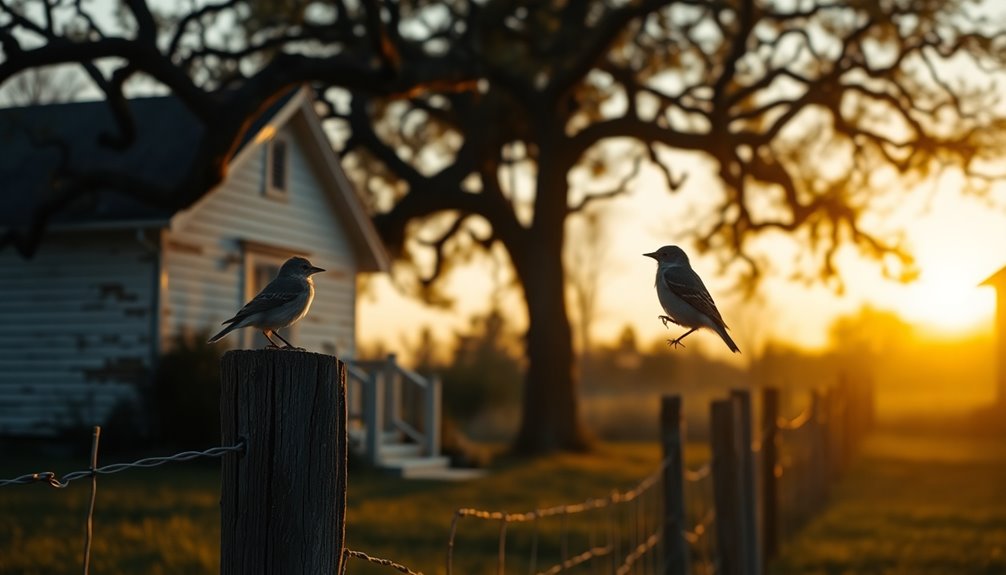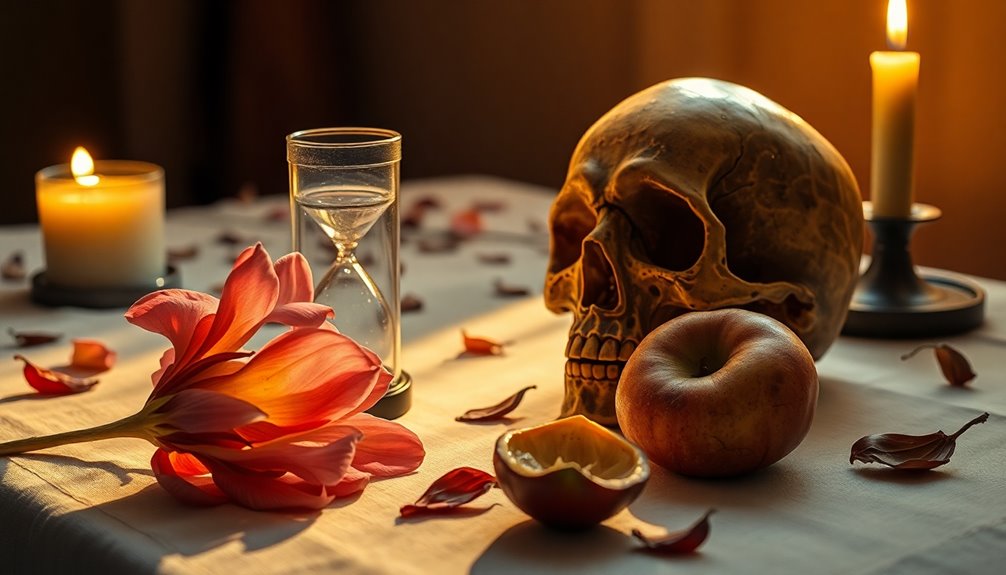In *To Kill a Mockingbird*, symbolism adds depth to the story by showcasing themes like innocence and justice. The mockingbird represents pure goodness, as seen in characters like Boo Radley and Tom Robinson. Boo, once feared, becomes a protector, reminding you that people can surprise you! The front porches symbolize community connections, allowing for important conversations and growth. Through symbols, characters learn about empathy and the harsh realities of their world. This thoughtful use of symbolism makes the story meaningful and exciting. Keep exploring, and you'll uncover even more fascinating insights into this classic tale!
Key Takeaways
- The mockingbird symbolizes innocence and goodness, representing characters like Tom Robinson and Boo Radley who embody moral integrity and beauty in the narrative.
- Mayella Ewell's geraniums reflect her desire for beauty amidst hardship, highlighting her complex character and the struggles she faces.
- Front porches symbolize social interactions and community engagement, providing a space for important conversations that shape characters' perspectives and beliefs.
- The rabid dog represents pervasive racism in Maycomb, illustrating the societal threats faced by those who challenge discriminatory beliefs and injustices.
- Miss Maudie's azaleas symbolize hope and resilience, emphasizing the beauty of nature and the enduring spirit of childhood amid chaos and adversity.
Symbolism of the Mockingbird

In "To Kill a Mockingbird," the mockingbird symbolizes innocence and beauty, representing characters like Tom Robinson and Boo Radley. Both of these characters show goodness, yet their lives are impacted by the harsh realities of society.
Atticus Finch teaches Jem and Scout that "it's a sin to kill a mockingbird." This lesson highlights the importance of protecting those who do no harm.
Tom Robinson's tragic fate reflects the theme of racial injustice, as his innocence is destroyed by prejudice. When you think of his death, it's like the slaughter of mockingbirds—an act of cruelty against the innocent.
Similarly, Scout learns that harming Boo Radley is also wrong. She realizes that Boo, like a mockingbird, only exists to bring joy and protection to others.
Miss Maudie reminds everyone that mockingbirds sing for enjoyment, emphasizing that true innocence should be cherished. This message encourages empathy and compassion in a world that often lacks both.
Boo Radley's Transformation

Boo Radley starts off as a mysterious figure shrouded in childhood fears and local myths, making him an embodiment of the unknown. You see, at first, Boo seems scary to Jem and Scout. They think he's a monster, but as they grow, their understanding transforms. Boo's actions, like leaving gifts for the children, show his kind and protective nature. This is where the magic happens!
As Scout matures, she learns to see Boo as a person rather than just a ghostly figure. This change is powerful! It highlights the importance of empathy and understanding. Boo's transformation from a reclusive character to a hero reveals the themes of innocence and the need to look beyond societal prejudices.
In the end, when Scout realizes Boo is like a mockingbird—someone who brings goodness without harm—it's a beautiful moment. It teaches her that harming those who do no harm is a real injustice.
Front Porches as Symbols

In "To Kill a Mockingbird," front porches act like bridges between private homes and the bustling community.
You'll notice that important conversations happen there, revealing what characters really think and feel about their world.
As you explore these porches, you'll see how they shape friendships and beliefs, helping Scout grow and understand the people around her.
Public and Private Spaces
Front porches serve as essential symbols in "To Kill a Mockingbird," representing the delicate line between private family life and the public sphere of Maycomb. These porches are more than just a place to sit; they're where social interaction happens.
Characters like Miss Maudie and Mrs. Dubose use their porches to connect with neighbors, sharing stories that reflect their beliefs and values. You can feel the warmth of community as they engage in conversations that shape relationships.
Key moments unfold on these porches, showcasing how characters relate to one another and to the world around them. For example, when Scout stands on Boo Radley's porch, she experiences a significant shift in her understanding of empathy.
It's a moment that marks her growth, as she sees things from a new perspective.
Social Interaction Dynamics
Transforming the way characters interact, front porches in "To Kill a Mockingbird" symbolize the nuanced dynamics of social engagement in Maycomb. These porches act as bridges between private lives and public interactions, where the community gathers to share gossip and opinions.
Imagine standing on Miss Maudie's porch, where she shares her wisdom and kindness, helping to strengthen connections among neighbors. Her porch becomes a space of learning, showing how essential social dynamics are in shaping beliefs.
For Scout, the porch represents a turning point. When she stands on Boo Radley's porch, she gains a deeper understanding of empathy. This moment grows her awareness of how others see the world, revealing the beauty of seeing life through someone else's eyes.
Porches, then, are more than just places to sit; they're crucial for community interactions and understanding. They help characters navigate who they're while engaging with the wider world.
In Maycomb, these spaces spark conversations and build relationships, illustrating how crucial social dynamics are in the lives of the characters. So, next time you think of porches, remember their powerful role in connecting hearts and minds!
Themes of Justice and Injustice

In "To Kill a Mockingbird," the trial of Tom Robinson shows just how unfair the justice system can be, especially due to racial prejudice.
You see, Atticus Finch stands up for what's right, showing his strong moral integrity, even when others don't agree with him.
This powerful story reminds us that true justice can be hard to find, and it's important to always seek the truth!
Racial Prejudice in Verdict
Racial prejudice consistently shapes the verdict in Tom Robinson's trial, reflecting the deep-seated biases of Maycomb society. The jury's verdict of guilty showcases how systemic injustices affect Black individuals. Despite Atticus Finch's strong defense, the truth is overshadowed by the community's racism. You can see this when Mayella Ewell's false testimony reveals her desperation, as she harms an innocent man to escape her own struggles.
Here's a quick look at the key points related to racial prejudice in the trial:
| Aspect | Description | Impact on Justice |
|---|---|---|
| Tom Robinson | Wrongly accused of a crime he didn't commit | Represents the innocent victim |
| Mayella Ewell | Her lies stem from fear and societal pressures | Highlights racial power dynamics |
| Jury's Verdict | Based on bias rather than facts | Questions fairness of the justice system |
The trial shows that the justice system often fails to protect the innocent, raising questions about moral integrity. Can true justice exist in a society filled with prejudice? This thought lingers long after the verdict is delivered, reminding us of the importance of fairness and equality.
Atticus's Moral Integrity
Representing the fight for justice in a flawed system, Atticus Finch stands as a moral compass in "To Kill a Mockingbird." He embodies integrity as he defends Tom Robinson, fully aware of the racial biases ingrained in Maycomb's society.
Atticus knows the challenges he faces, yet he remains committed to justice. He believes everyone deserves a fair trial, no matter their skin color.
By taking on Tom's case, Atticus highlights the racial injustices that plague his community. He becomes a beacon of hope, showing that empathy can shine through even the darkest times.
When the jury delivers a guilty verdict, it's a painful reminder of the societal biases that exist. But Atticus doesn't give up; he stands firm in his beliefs.
Through his actions, Atticus teaches his children valuable lessons about empathy and fighting against injustice. He encourages them to see the world through others' eyes, helping them grow into compassionate individuals.
His moral integrity inspires not just his family, but everyone who witnesses his courage. In a world filled with unfairness, Atticus Finch reminds us that standing up for what's right is always worth it.
Character Development Through Symbols

Symbolism plays an essential role in character development throughout *To Kill a Mockingbird*, revealing the depth of the characters and their journeys. The mockingbird represents innocence, especially in characters like Tom Robinson and Boo Radley. Both face harsh realities that challenge their moral purity.
As you read, you'll notice how Scout's understanding of Boo transforms. She starts with childhood fears but grows to see him as a protector, showing her developing empathy.
Jem's lessons with Mrs. Dubose's camellias teach him about courage and the complexity of human character. He learns that fighting personal battles is important, even when the odds seem against you.
Atticus Finch stands as a symbol of moral integrity, defending Tom Robinson and teaching his children about justice.
Even Mayella Ewell's geraniums symbolize her desire for beauty in a harsh world, reflecting her internal struggle.
These symbols highlight the characters' growth and the lessons they learn, guiding you through their experiences. As you explore these symbols, you'll appreciate how they enhance your understanding of innocence and the moral challenges within the story.
Additional Symbolic Elements

As you continue exploring the layers of *To Kill a Mockingbird*, you'll encounter additional symbolic elements that enrich the narrative. One striking symbol is the rabid dog, representing the pervasive racism in Maycomb. Just like a threat, it mirrors the harsh realities faced by those who challenge discriminatory beliefs.
Then there's Miss Maudie's azaleas, a beautiful creature of nature that stands for hope and resilience. These flowers remind Scout and Jem that beauty can exist even in tough times, symbolizing the innocence of childhood amidst chaos.
Mayella Ewell's geraniums reveal her yearning for a better life, highlighting the complexity of her character and her struggle against her oppressive family. Meanwhile, Mrs. Dubose's camellias serve as a reminder of the entrenched prejudices within the community. They symbolize her personal battles and the fight against societal norms.
Throughout the story, these plants and flowers act as metaphors, illustrating the characters' inner lives. They show us that while the world can be harsh, there's always room for beauty, hope, and resilience. This adds depth to the story, making it even more engaging for you as a reader.
Frequently Asked Questions
Which of the Following Is a Symbol in to Kill a Mockingbird?
One symbol in *To Kill a Mockingbird* is the mockingbird itself. It represents innocence and goodness.
You'll see characters like Tom Robinson and Boo Radley embody this symbol, as their lives are affected by the harshness of others. Just like a mockingbird, they don't harm anyone but still suffer.
This symbol shows how important it's to protect those who are innocent and to stand against cruelty. Isn't that a powerful message?
What Symbols Represent Boo Radley?
Boo Radley represents so much more than just a spooky neighbor—he's like a hidden treasure waiting to be discovered!
Symbols of Boo include the gifts he leaves for Scout and Jem, showing his kindness, and the blanket he wraps around Scout during a crisis, representing his protection.
As you learn about him, you realize he embodies innocence, reminding you to look beyond appearances and understand the goodness that lies within everyone.
What Do Guns Symbolize in to Kill a Mockingbird?
In "To Kill a Mockingbird," guns symbolize both protection and danger. When Atticus uses his gun, it shows his responsibility to defend his family and community.
But his reluctance to use it highlights his belief in non-violence. On the other hand, characters like Bob Ewell misuse guns, showing how power can lead to harm.
This duality teaches us about the importance of using power wisely and understanding the consequences of our actions.
How Does the Symbolism of Killing a Mockingbird Fit Into the Story Are There Any Examples of Mockingbirds Demonstrated in the Story?
Killing a mockingbird in literature is like squashing a rare gem—it's just wrong!
In the story, Tom Robinson and Boo Radley are perfect examples of these innocent mockingbirds. Tom faces tragedy despite being good-hearted, while Boo transforms from a misunderstood figure to a brave protector.
You see, their experiences show the importance of kindness and understanding toward those who are vulnerable, reminding you to cherish and protect innocence in the world.
Conclusion
In "To Kill a Mockingbird," symbolism weaves a rich tapestry of meaning throughout the story. It helps you see the beauty in innocence, like the mockingbird itself. From Boo Radley's journey to the significance of front porches, each symbol invites you to explore deeper themes of justice and growth. Just like a puzzle coming together, these symbols reveal the heart of the novel. So, as you turn the pages, let the symbols guide you on this exciting adventure!











